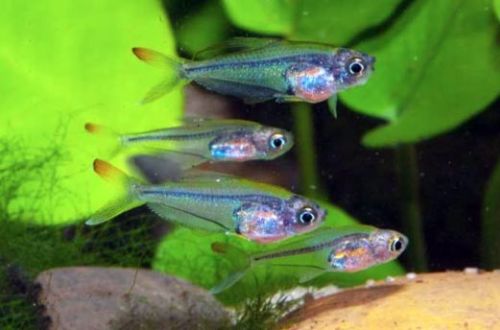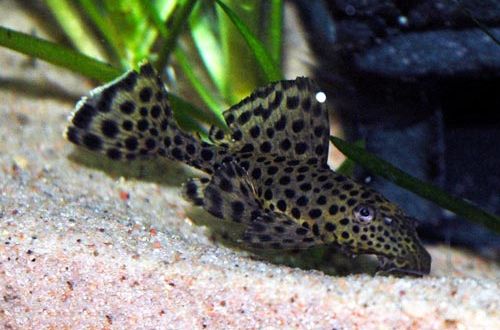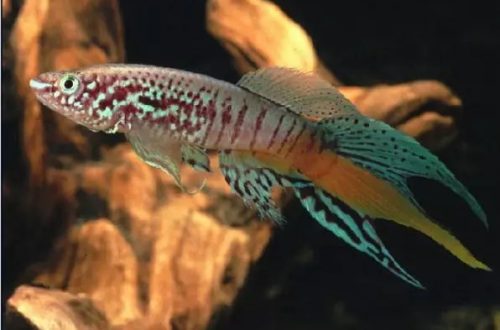
Tetra hummingbird
The hummingbird tetra, scientific name Trochilocharax ornatus, belongs to the Characins family. This fish lives up to its name, being one of the smallest species available in the aquarium hobby. Quite demanding on the conditions of detention, there may be difficulties in breeding. Due to their modest size, it is difficult to find aquarium neighbors. All this makes it not the best choice for beginners.

Contents
Habitat
It comes from South America from the upper reaches of the Amazon River from the Loreto region in northeastern Peru. Inhabits small forest streams and channels, as well as small river channels. The natural habitat contains many snags and fallen leaves on a sandy substrate, which in the process of decomposition saturates the water with tannins, from which it turns brown.
Brief information:
- The volume of the aquarium – from 40 liters.
- Temperature – 20-28°C
- Value pH — 4.0–6.5
- Water hardness – 1–5 dGH
- Substrate type – any
- Lighting – subdued, moderate
- Brackish water – no
- Water movement – moderate
- The size of the fish is up to 2 cm.
- Food – any food
- Temperament – peaceful
- Keeping in a group of 8-10 individuals
Description
Adult individuals do not reach a length of 2 cm, the maximum recorded fish are measured at 17 mm. Sexual dimorphism is weakly expressed, males and females are similar to each other and do not have pronounced differences. The color is gray with a blue tint. The fins are translucent, the tip of the tail is red, and the pelvic fins are yellowish.
Food
Accepts all types of food popular in the aquarium trade. The food served must be made up of tiny particles, otherwise the fish will not be able to eat them. The daily diet may consist of dry, freeze-dried, live or frozen foods.
Maintenance and care, arrangement of the aquarium
The optimal size of the aquarium for a flock of 8-10 fish starts from 40 liters. The decoration is arbitrary, but the best choice is the use of natural elements when decorating, for example, sandy soil, driftwood, aquatic vegetation. The lighting is subdued, so you should give preference to shade-loving plant varieties, mosses, ferns.
It is recommended to add dried leaves of some trees to the aquarium. When they decompose, processes similar to those that occur in natural reservoirs will occur. Tannins will begin to be released, giving the water its characteristic chemical composition. At the same time, it will turn brown. In addition, the leaves can serve as a source of valuable secondary food for fry – shoe ciliates.
Tetra hummingbirds should be kept in soft water with acidic pH values. You may need to purchase filters with a chemical cleaning function that will further acidify the water, as well as use a reverse osmosis system to reduce overall hardness. The fish is sensitive to fluctuations in temperature and hydrochemical values. It is important to ensure stable water conditions and prevent the accumulation of organic waste.
Behavior and Compatibility
A peaceful schooling fish, it is necessary to maintain in a group of 8-10 individuals. The choice of neighbors should be taken with great care, since any more or less large fish can intimidate such a small Tetra hummingbird. If in nature they can swim away from potential danger, then in a closed artificial environment this will not work. In small tanks only compatible with species of comparable size.
Breeding / breeding
Under favorable conditions (suitable environment and high-quality food), the fish often come into a spawning state, so breeding does not cause great difficulties. Much more problems are associated with rearing offspring, which are very small and need microscopic food such as shoe ciliates.
Fish diseases
Diseases inherent in this particular species of fish were not noted. When kept in suitable conditions (high water quality, balanced diet, non-conflict neighbors, etc.), health problems are not observed. The most common cause of disease is the deterioration of conditions leading to immune suppression, which makes the fish susceptible to infections that are invariably present in the surrounding area. When the first signs of an illness are detected (lethargy, exhaustion, refusal of food, lowered fins, etc.), it is necessary to immediately check the main parameters of the water. Often, the restoration of acceptable living conditions contributes to self-healing, but if the fish is too weak or has received obvious damage, medical treatment will be required. For more information on symptoms and treatments, see the Aquarium Fish Diseases section.





